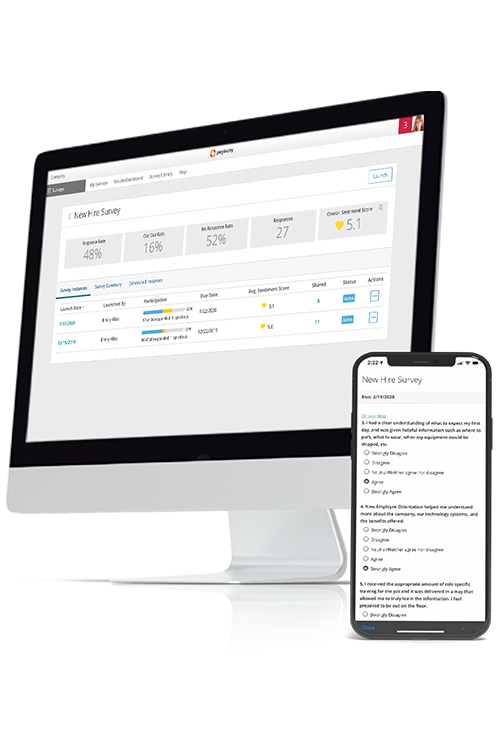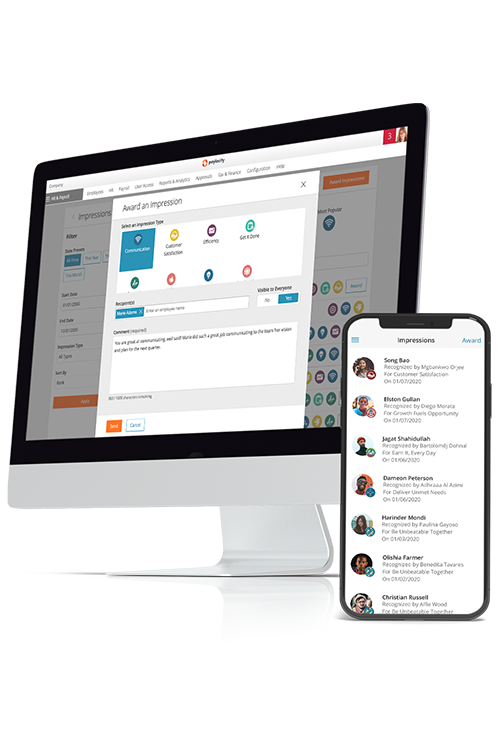Related Learning

What’s Driving Your High Turnover Rate (And What to Do About It)
High employee turnover almost always starts with a few missed signals.
A few employees send in their resignation letters and head onto exciting new roles with a few cheerful high-fives and handshakes. Then, a handful more go.
You tell yourself it’s just normal churn, right?
But before long, you’ve got a line of employees queuing for the exit, you’re offboarding faster than you can manage, and you’re still none the wiser about what’s actually happening.
High turnover can happen to any organization at any time — but it rarely comes without a few warning signs. Learning how to spot the signals and acting before turnover skyrockets is an organization’s best chance at keeping its best employees.
Here’s what’s driving your high turnover rate and the actions HR teams can take to prevent it.
Key Takeaways
- High employee turnover is when the rate and pace of employee departures exceed an organization’s baseline.
- High turnover rates often signal deeper issues, including employee disengagement, lack of professional development, or operational challenges.
- Two-way feedback and data collection are critical to identifying and addressing the root causes of turnover.
What is Considered High Employee Turnover?
When we talk about high employee turnover, we don’t just mean a few employee departures here and there. We mean a sustained turnover rate — voluntary and involuntary — that exceeds your organization’s normal baseline.
This baseline isn’t one-size-fits-all. While the average U.S. turnover rate sits at 13.5%, other industries may experience higher or lower rates.
For example, the Bureau of Labor Statistics reports that the hospitality, construction, and retail industries have some of the highest separation rates. This is usually due to industry-specific factors like seasonal hiring demands and fluctuating short-term staffing needs.
How to Calculate Turnover Rate
Calculating your organization’s turnover baseline and understanding how it stacks up against your industry sector starts with a simple formula:
Employee turnover rate = (Number of Employee Separations / Average # of Employees ) x 100
Your turnover rate is a North-Star metric that helps you identify when something isn’t working with your employee experience. Tracking how this fluctuates over time, and drilling down into turnover by sector, helps you identify your biggest pressure points, and diagnose their root causes.
What Causes High Turnover?
There are many reasons why people quit. But when turnover skyrockets, it’s usually a sign of systemic issues, like a toxic company culture, a lack of professional growth opportunities, or inequitable performance management processes.
And perhaps the biggest sore thumb of them all: employee disengagement.
In our study of employee retention factors, we found that while employee engagement decreases over time, certain factors, like whether or not employees find their work meaningful, were strong predictors of tenure length.
Employees who strongly agreed that their work is challenging, stimulating, and rewarding have a 73% chance of staying five years or more, compared to a 39% chance for those who strongly disagree.
Other key factors that determine whether an employee stays or goes include job satisfaction, leadership support, and having the right tools to do the job well.
But even when these factors are in place, the everyday operational reality of work beyond HR’s control can also drive up turnover. High workloads, poor work-life balance, lean teams, and unclear direction can lead to burnout, discontent, and, ultimately, a mass exodus.
Lance Robbins, Head of HR at Provivi, Inc, explains how chronic understaffing can exacerbate issues that lead to higher turnover.
“Budgets are often based on an already skeleton staff, leaving no room to relieve the employee’s workload,” Robbins said. “This constant pressure is a one-way ticket to burnout city, and it’s no surprise that many employees hop off the train before it reaches the destination.”
And when company leaders make reactive decisions or choose to operate with limited resources, they are often only considering the short term.
The result, Robbins added, is wasted time and effort on abandoned projects and unnecessary tasks, contributing to higher attrition rates.
What is the Impact of High Turnover?
Beyond the obvious effects on employee workload and morale, high and sustained turnover also eats into your bottom line.
Scratchpad estimates put the total cost of turnover at between 50% and 200% of an employee’s salary, depending on the role’s seniority, business importance, and scarcity.
This figure reflects more than just the time and money spent recruiting, onboarding, and ramping up a new hire — it quantifies the widespread disruption to projects and productivity.and productivity.
Over time, this impact compounds at every level of the business:
- Morale and engagement: Studies consistently link high turnover to decreasing engagement. When many team members leave simultaneously, it disrupts team dynamics and adds a hidden emotional strain. Remaining team members often feel anxious and uncertain while having to pick up the slack —, leading to a dip in their motivation.
- Productivity: When morale dips, so does productivity. Fewer hands on deck often means that remaining team members absorb the additional workload. Shifting priorities results in delays in service and project delivery.
- Voluntary turnover: High turnover and simmering employee discontent can lead to even higher levels of turnover if organizations aren’t quick to act. Research has coined this as “turnover contagion,” where a wave of quits makes other employees reassess their overall job satisfaction.
- Customer satisfaction: Employee engagement is critical for customer satisfaction and retention. And when employee morale is low, it can ripple outward into customer relationships, leading to slower service and inconsistent experiences.
Shelby Lepage, director of HR at Case IQ, explains the broad and emotional impact of employee attrition.
“When people leave, they take more than just their role with them,” Lepage says. “They take context, institutional memory, and the sense of continuity that builds team trust. There’s also the emotional toll. Other employees get weary of the constant onboarding of new faces, and quietly start wondering if they should be next to go.”
How to Address High Turnover
High turnover is a big, blinking warning light that something isn’t working in your organization. But going on a recruiting blitz to fill empty seats is only addressing the symptoms. Instead, go deeper to examine how HR systems and processes support retention in the first place.
This hinges on collecting the right data and feedback pointing to the root causes of your biggest retention challenges. Often, you’ll need a robust HCM system with the ability to collect and visualize pertinent data points, especially if you have a larger workforce.
1. Collect Data on Leading Indicators
Turnover data is like looking in the rearview mirror: You only know something’s wrong after it’s passed you by. Staying one step ahead of high turnover relies on getting data-driven about where and why it’s happening across your organization.
Start by segmenting your turnover data by factors like office location, role, level, and other demographic data. This will tell you which pockets of your organization are experiencing higher turnover than others — and might hint at a few reasons why.
Then, you need to overlay this data with leading indicators that predict future turnover risk. These indicators give you a chance to act and stem the tide.
Robbins, head of HR at Provivi, Inc, emphasizes that leaders must consistently gather and listen to feedback. Early signals can reveal key risks like burnout, connection to the organization’s mission, and the effectiveness of managers.
“These are the early signs that show where employees are disengaging before they leave,” Robbins says. “If you’re not asking, you won’t know.”
2. Create Mechanisms for Two-Way Feedback
Next, you need to pair your survey data with qualitative insights that add nuance to employees’ actual work experience. This hinges on giving employees the opportunity — with no judgment attached — to freely give their opinion and have a two-way conversation.
“Turnover is the smoke, not the fire,” said Lepage, the HR director at Case IQ. “We are big advocates for speak-up culture. When employees trust that they can raise concerns without fallout, you get ahead of issues before they become exits.”
Lepage said he’s had the most success tracking employee sentiment in real time, using pulse surveys, anonymous feedback tools, and even watching internal mobility patterns.
Equally important to tracking is following up. Continually asking for feedback without taking it will erode employees’ trust in management and the organization.
3. Review Talent Growth and Development Pathways
According to 2024 data from Gallup, over half (51%) of employees would leave their current role if something better came along.
And data from LinkedIn’s 2025 Workplace Learning Report found that organizations that prioritize career development are more likely to both attract great talent and retain it.
The takeaway: When employees have nowhere left to grow, they’re far more likely to go. But fixing missed development opportunities isn’t just a case of offering a few more learning materials — it’s understanding the systemic challenges to growth within your company’s talent development pathways.
Tracking promotion rates, title changes, and internal mobility alongside retention data will reveal where growth pathways are working — and where they’re stalled. Identifying which segments of your workforce are more likely to get promoted than others will also help identify any equity gaps or inconsistencies in growth processes
And remember that not all growth has to be vertical. HR teams must also analyze their skills landscape, evaluate mentorship opportunities, and promote cross-functional opportunities like job shadowing or role rotations.
4. Implement a Meaningful Rewards and Recognition Program
Gallup data shows that well-recognized employees are 45% less likely to leave within two years, making recognition one of the most powerful tools for combating high turnover.
A robust rewards and recognition program signals to your workforce that their efforts aren’t going unnoticed. And it doesn’t have to be flashy or expensive. What matters is that it’s consistent, fair, and aligned with what employees actually care about.
Recognition can take many forms: shoutouts in team meetings, spot bonuses, personalized thank-you notes, or public praise on internal platforms.
5. Improve Communication and Transparency
You can have all the data in the world about what’s causing your high turnover. But without clear, open, and honest communication, none of your actions to address it will land effectively.
Getting ahead of any potential rumors and rumblings of discontent relies on creating transparent lines of communication across your organization. Simple, honest, and fact-driven messaging is key to maintaining employee trust when anxiety is running high. Senior leaders must provide regular, straightforward updates on what’s happening, why, and what it means for their workforce.
Tackle High Turnover with Paylocity
A high turnover rate should be a wake-up call to your organization. And integrating a data-driven solution with real-time employee feedback is a serious answer.
Paylocity’s platform is built to bridge the gap between data and action, collating real-time feedback, streamlining reporting, and providing clear next steps to advance your engagement and retention efforts.
Tackle high turnover with features like:
- Learning and Performance tools that empower managers to support employee development and drive career progression.
- Employee Voice for capturing feedback and addressing concerns before employees consider leaving.
- Recognition and Rewards for simplifying recognition with diverse reward options and automated taxation.
Want to learn more? Book a demo today!









